The Complete, Visual Guide to On-Page SEO in 2024 (With Templates!)
If you’ve ever considered a page ranking at the top of Google to be “lucky,” think again. For any such lucky duck, majestically perched at the top of the SERP, you can rest assured there’s a host of legwork going on beneath the surface to make this possible.
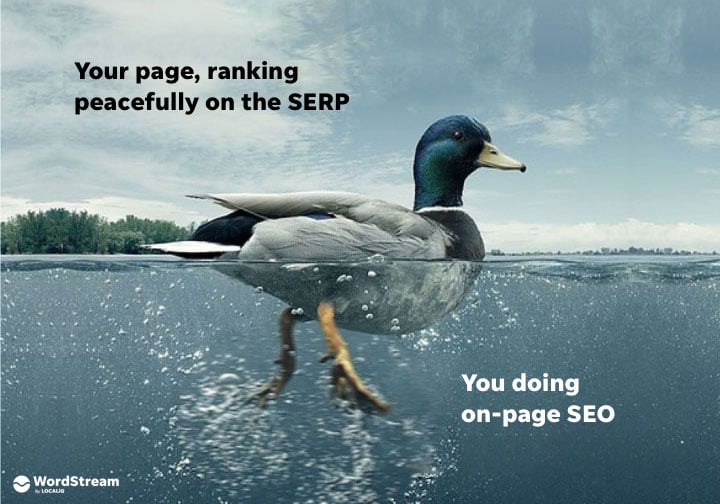
Said legwork is called SEO, but once you get the hang of it, it becomes like second nature. So in this guide, I’m going to turn the complex process of on-page SEO into a step-by-step, visual guide to make this possible for you.
Ready to start ranking higher and get more traffic to your website?
Quack 🦆
Contents
- What is on-page SEO?
- On-page SEO vs off-page SEO
- The 11-point on-page SEO checklist
- On-page SEO checkers
- On-page SEO templates
What is on-page SEO?
Just as the name sounds, on-page SEO refers to the optimizations you make to a specific page on your website to get it to rank higher on the SERP for queries related to the keyword it’s targeting. Some of those optimizations are visible on the page itself while others are behind the scenes. This, of course, translates to more relevant traffic to that page, and the more pages optimized on your website, the stronger your SEO muscles become.
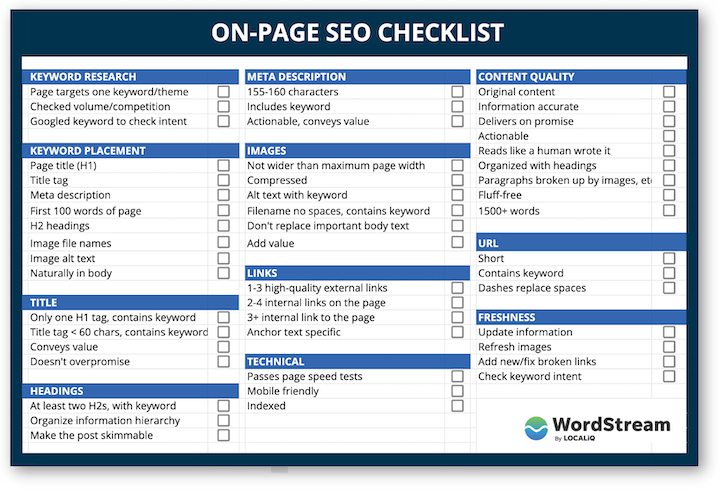
Save image | Go to the Google Sheet
On-page vs off-page SEO
To understand the difference between on-page and off-page SEO, it’s best to go back to the SEO basics. There are three core types of SEO:
- On-page SEO refers to efforts made directly to the page you’re trying to optimize, such as improving its content or adding keywords.
- Off-page SEO refers to efforts made on other pages of your site, or with other sites, to help your page to rank, such as with backlinking, listings, social promotion, guest posting, PR, and more.
- Technical SEO refers to efforts involving the site’s source code, sitemap, speed, security, structured data, and more words that don’t begin with S.
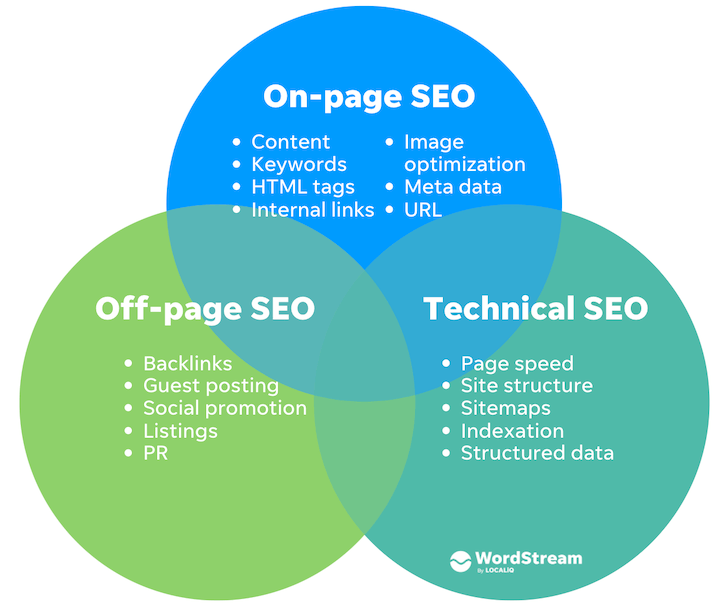
While the overlapping circles look nice, they’re presented that way because these efforts are all interconnected. For example, you’re not going to get backlinks (off-page) if your page content isn’t quality (on-page), and compressing images (on-page) helps with page speed (technical).
On-page SEO checklist
In the rest of this post, you’re going to learn how to do on-page SEO like never before. But like I said, it’s a hefty hustle, so here’s the bird’s eye view of your on-page SEO checklist:
- Keyword research
- Content quality
- Keyword placement
- Images
- Title
- Headings
- Meta description
- URL
- Links
- Technical
- Content freshness
And here’s the video version of this post!
1. Keyword research
First and foremost, do your keyword research. You can’t do any of the steps in this post if you don’t know what keyword you’re targeting. We show you how to do keyword research here, but here are a few tips:
- Your blog posts are where you’ll do most of your keyword targeting and on-page SEO.
- Use keyword research tools to find keywords with decent volume and low competition.
- Target one keyword or keyword theme per page. For example, this post targets the keyword “on-page SEO” as well as “on page seo checklist” and “what is on page seo” because if I wrote separate posts on each keyword, they’d compete against one another in the SERP.
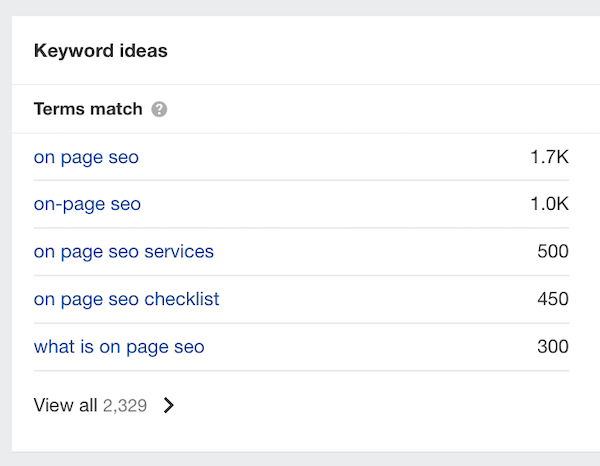
- Google your keywords. If you do all of the steps below but the content of your page doesn’t match the intent of the keyword you’re targeting, you’re not going to rank!
2. Content quality
Google defines thin content as inauthentic and providing little value—like auto-generated copy, thin affiliate pages, scraped content, and doorway pages.
But just because your page doesn’t fit the above criteria doesn’t mean your content isn’t thin. The important word above is “value.” If you want your page to rank for the keyword it’s targeting, it needs to be:
- Trustworthy: information is accurate and delivers on the promise of the headline.
- Useful: provides the information a user is seeking when they search that keyword.
- Actionable: all “what”s should be accompanied by “how”s, even if that means a link to a separate resource.
- Readable: information is organized, scannable via headers, reads like a human wrote it, and text is broken up by images, bullets, call-out quotes, and other visual elements.
- Adequate length: if the page you’re optimizing is a blog post, aim for at least 1,500 words. Hubspot recommends 2,100-2,400 words based on the average length of its top 50 blog posts, but also mentions that a third of those top posts were less than 1,500 words. We talk more about how long a blog post should be here.
- Free of fluff: i.e., it does not use many words to say little. See below:
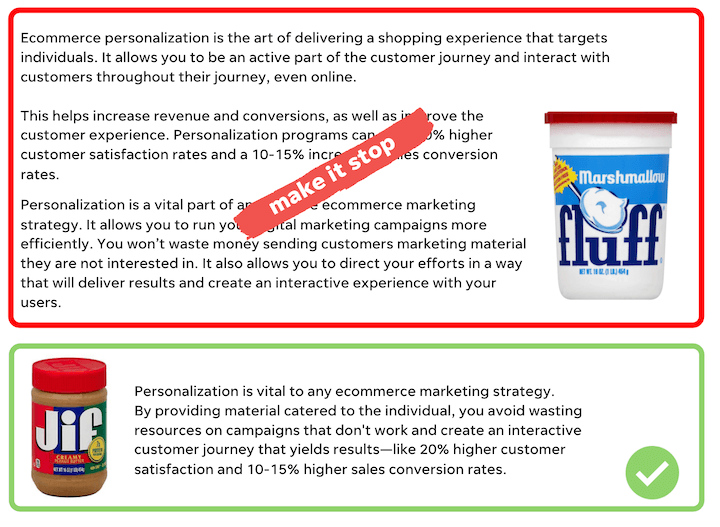
121 words of empty-calorie robotic fluff with no nutritional value
vs
44 words of protein-packed peanut butter
3. Keyword placement
Now if you’re writing quality content like a human, the keyword and related LSI keywords will occur naturally in the body of the text. But there are some places where you need to intentionally place your target keyword. These include:
- Page title: This is the title of the page as it appears on the page.
- Title tag: This is the title of the page as it appears on the SERP.
- First 100 words of the page: Make sure this is incorporated naturally.
- Headings: ideally in at least two H2s on the page.
- Meta description: This is the summary of your page that appears on the SERP.
- Image alt text: The text alternative of an image.
- Image file name: Don’t just save an image as “Screenshot-1” or “chart.”
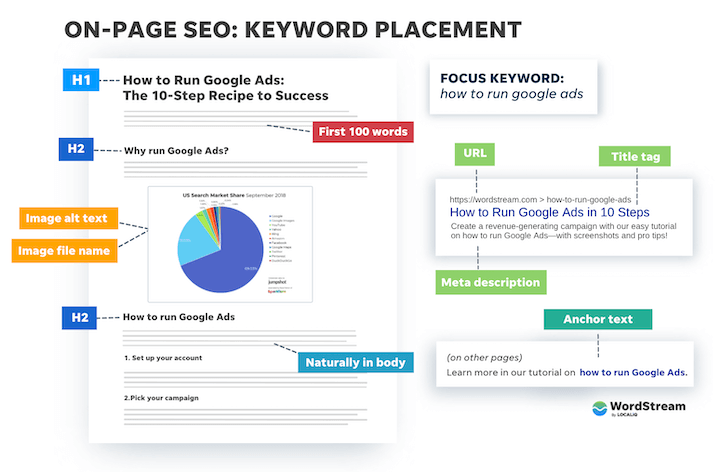
If you were confused by the above list, don’t worry—the rest of this guide will dive deeper into each one.
4. Images
Images on their own are an on-page optimization since they keep readers engaged with a page, and time on page factors into ranking. But there’s more to images on a page than meets the eye. Here is your image optimization checklist:
- Optimize for speed: Resize your images so their width doesn’t exceed the maximum width of the page (your site will resize them automatically, but this still requires requests to the server), and compress them to reduce file size without sacrificing quality (I use tinypng.com because it’s fast, free, and has a cute panda on it.) If you have a particularly large site with lots of images, you may want to look into a content delivery network (CDN).
- Add alt text: This is the text alternative of an image. This is how you tell Google (and how screen readers can tell the visually impaired) what your image is about, and should contain the keyword you’re targeting.
- Convey value: Use images to illustrate the concepts on your page, such as with graphs, screenshots, and even your own illustrations (how to use Canva here!) not empty graphics.
- Don’t replace text with images: Alt text is only meant to be a few words, so when you’re using an image to convey information relevant to the keyword you’re targeting, make sure that information is also written out in the body text of the page.
- Optimize filename: The name of the image file you upload to your page should contain the keyword you’re targeting. Be sure also to replace spaces in the filename with dashes or underscores. Otherwise, they’ll get replaced with “%20” or some other jibberish that doesn’t look trustworthy and can impact your image’s ranking in image results.
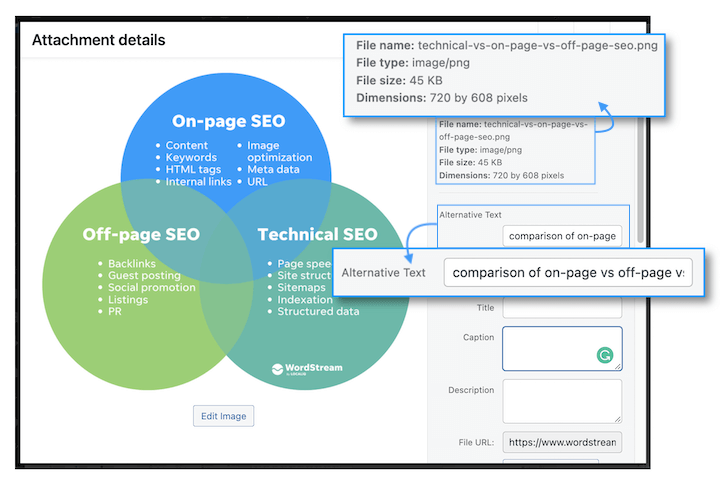
Here’s what alt text, file name, file size, and dimensions look like in WordPress.
In the image at the top of this post, I optimized for the keyword “on-page vs off-page SEO.” My alt text reads “comparison of on-page vs off-page vs technical SEO,” my file name is “technical-vs-on-page-vs-off-page-seo.png, and I’ve both compressed and resized the image.
5. Title
There are two different titles for any given web page on a website:
- Title tag: Also known as the meta title or SEO title, this is the title of the page as it appears in search results. An optimal title tag is 60 characters or less and contains the keyword you’re targeting. Be sure to front-load the headline with the keyword to make sure it doesn’t get cut off on smaller screens.
- H1 tag: This is the title of the page that readers see when on the page. You have more room here to be creative and convey value here, but it should still contain the keyword.
Your title tag and H1 tag don’t have to be different, but it’s good to know you have this option. Regardless, a strong headline is a must for on-page SEO since it impacts whether or not users click through to your page. A strong headline:
- Conveys value. What’s in it for the reader? “7 Yoga Poses to Try Today” doesn’t give me a reason to click. “7 Yoga Poses That Improve Sleep” on the other hand, does.
- Doesn’t overpromise. Don’t call it an ultimate guide if it isn’t one, or change it to match other top-ranking pages for that query if it doesn’t contain that content.
- Is descriptive. “Services” might work as a page title on your website, but on the SERP, this could mean anything. Instead, go with “Affordable Norfolk Landscaping Service Packages”
- Is interesting. This does not mean using caps, hyperbolic words, or exclamation points! Use power words, like “supercharge” instead of “improve.” You can refer to these 88 headline examples for ideas and guidance.
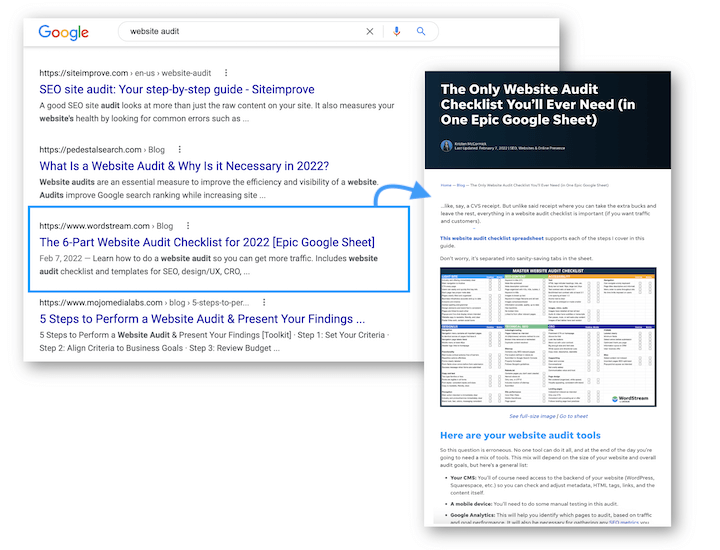
Short, SERP-friendly title tag on the left; longer, more brand voicey H1 title on the right (and a post that delivers on its promise).
6. Headings
Headings are used to organize the information on your page into clear sections and subsections. These convey to readers the hierarchy of the page, but Google needs to know that too in order to understand its relevance to the keyword you’re targeting. But it can’t identify headings based on font size and weight of font like we can. Instead, Google sees in HTML.
There are six types of heading tags. If you’re using a CMS like WordPress, SquareSpace, etc., you’ll see a drop-down menu of heading tags in your editor (you can customize the sizes of these headings as well), but you can also manually apply them in the HTML code.
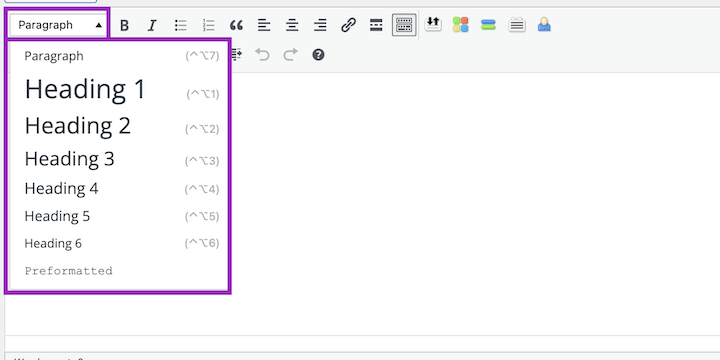
- <H1> is the title of the page; you should have only one H1 per page.
- <H2> labels the main sections of your content. A well-optimized page could have anywhere from two to 22 H2s (that’s a lotta twos right there), depending on how much content there is, but you should always have at least two that contain the keywords you’re targeting—which should be easy to do with one section in your post and the conclusion.
- <H3> these are used to further label the different points made in each H2 section. Use these as needed, but don’t force it and don’t worry about having keywords here.
- <H4> to <H6> These headings don’t really have SEO value, and if you’re chopping up your content that much, it’s probably not going to be very readable. I do sometimes use H4s but only once in a blue moon.
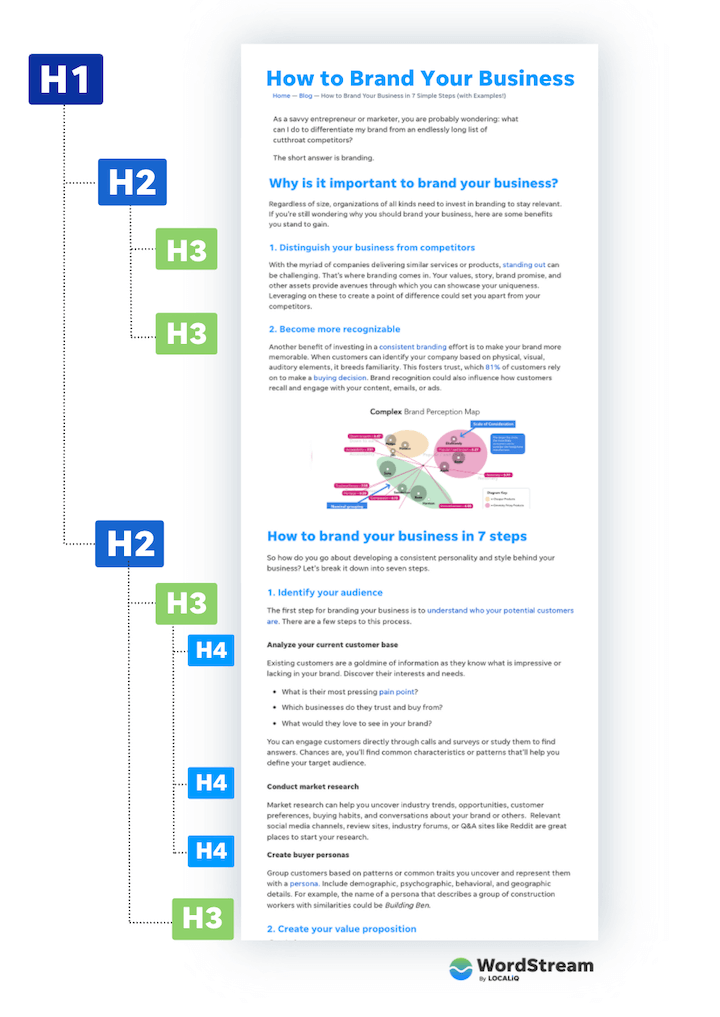
Heading tags also enable Google to surface your page in results for more specific queries related to the page, allowing you more opportunities to appear on the first page of Google. The biggest thing to remember with headings is to make sure they’re descriptive. A reader should be able to get the gist of the page just by skimming the headings.
7. Meta description
The meta description is the description of your page that appears under the title on the SERP. Consider it the ad for your page, as a well-written meta description tells searchers your post will answer their query and gets them to click. Here’s your meta description checklist:
- Keep it between 155-160 characters.
- Include the keyword you’re targeting, and related keywords if it makes sense.
- Make it actionable and communicate benefit. For example
- “This post provides a list of power words and alternative versions of common words to use in your marketing materials.”
- Write more memorable marketing copy with this list of over 350 power words and phrases—for emails, blogs, social, ads, and more!

Google won’t always use the meta description you’ve provided. It dynamically creates them from your content based on the query—which is why it’s important to have those heading tags in there. Keep in mind also that the meta description also appears in preview snippets, like the ones you see on social media.
Get a free, fast, on-page SEO audit with our free Website Grader!
8. URL
Most, if not all CMSs generate an automatic URL for your page—sometimes the title you’ve given it or sometimes a string of numbers. You’ll want to edit this URL to:
- Contain the keyword you’re targeting
- Use dashes instead of spaces
- Keep it short. The keyword itself will suffice in almost all cases.
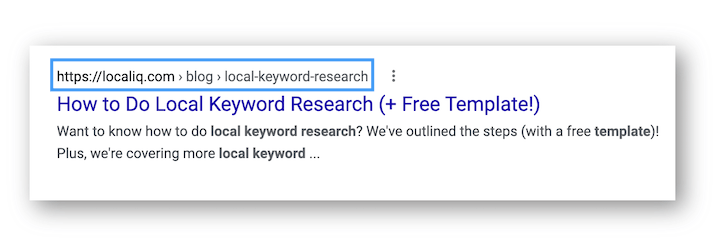
Had this URL been https://localiq.com/post-2844, would you have trusted it enough to click it?
9. Links
There are two types of links involved in on-page SEO—internal links and external links (also called backlinks). We shares some great intel on linking in this 10-step SEO audit, but here are the basics.
External links
These are the links on your page that take users to other domains. An on-page SEO best practice is to link out to pages on the topic from websites with high domain authority. This helps Google to trust your page more. In his SEO techniques post, Brian Dean recommends linking out to at least 3 high-quality domains
Internal links
These are the links on your page that take the reader to other pages on your site. Your page should not only include internal links, but other pages on your site should link to the one you’re optimizing.
For any case with linking, the anchor text should be specific to the page you’re linking to and contain the keyword it’s targeting. Not only does this make for a better user experience, but the more links to your page that use the keyword as the anchor text, the better your chances of ranking (learn more about keyword mapping).
10. A *few* technical optimizations
I know, I know, this is not a technical SEO checklist, but like I said earlier, the different types of SEO are interconnected. Below are some things that should already be in place, but sometimes have glitches so they’re easy troubleshooting if your page is not performing as well as you expected.
- Mobile-friendliness: Your site as a whole should be built with responsive design—meaning it will adjust to any screen size—but sometimes, elements fall through the cracks. If you’ve embedded a video or added a table to your page, for example, double-check to make sure it’s appearing properly on mobile.
- Crawlability: Your page can’t rank if it’s not indexed. And it can’t be indexed if it’s not crawlable. If your website shows up on the SERP, it’s indexed. But sometimes, blog posts or pages get accidentally unindexed for one reason or another. If a page is getting unexpectedly low traffic, check the back end of the page in your CMS to make sure indexing isn’t turned off. If it isn’t, you can use Search Console to troubleshoot.
- Social share buttons: This is done at the site level, usually through a plugin, and makes it easier for others to amplify your content. Just make sure the plugin doesn’t slow down your site.
- Page speed: Page speed is a ranking factor, and oversized images aren’t the only thing that can drag a page down. Use PageSpeed Insights to check the speed of your individual page. Both tools will tell you what you need to do if you have a poor score.
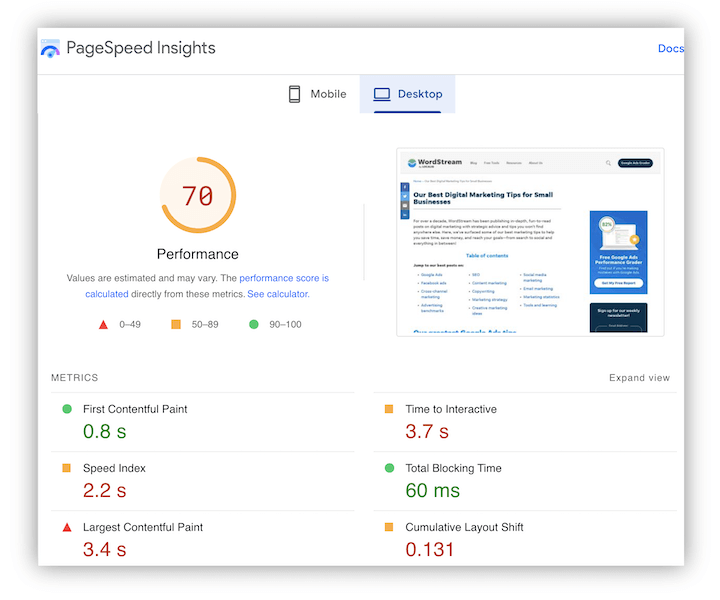
11. Content freshness
The importance of content freshness can vary depending on the query, but it’s important to periodically update any page you want to rank to preserve its value. I have a complete content refresh checklist here, but for a sneak peek, here are some updates you can make:
- Update or add new information.
- Add links to new content and fix any broken links.
- Replace old images (especially graphs and platform screenshots).
- Check to make sure the intent of the keyword hasn’t changed.
Free on-page SEO checkers
As you can now see, a page ranking at the top of Google isn’t just effortlessly streaming along. There’s a lot of work that goes into it, and this is for every page on your site. Luckily, there are on-page SEO checkers to help you out.
- SEO tools: Free trials from sites like Ahrefs and Semrush can run comprehensive audits on your website to check for on-page, off-page, and technical SEO factors. These are best for SEO specialists who know what to look for and how to read the results.
- WordPress plugins: Namely Yoast, which will provide a score and suggestions on the readability and keyword targeting of your content. Take these suggestions with a grain of salt though.
- Website graders: These tools are more beginner-friendly. LOCALiQ’s Free Website Grader provides a report like the one below, explaining what the results mean and prioritizing action items for you.
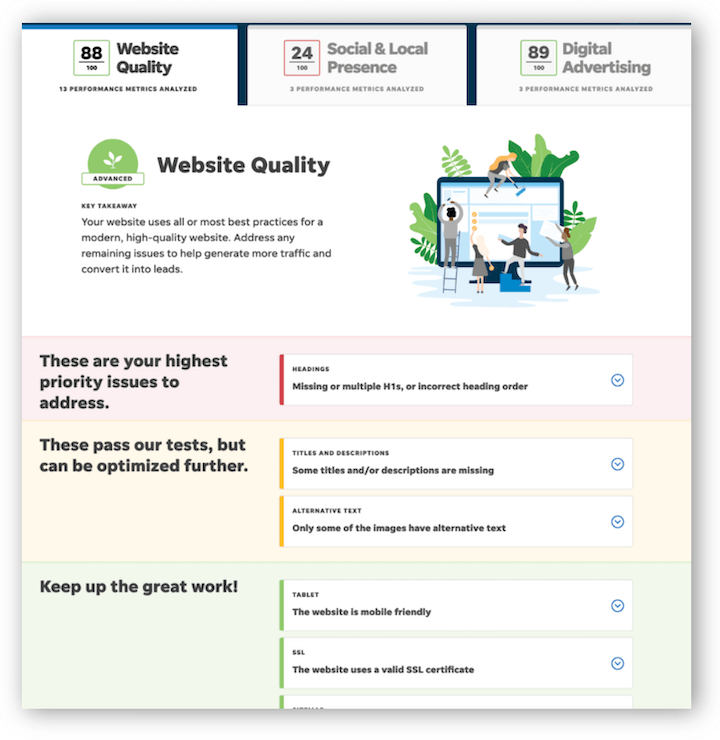
Use the free LOCALiQ Website Grader to get a report like this for your website.
On-page SEO templates
To make your life easier, I have a few templates for you.
On-page SEO checklist template
The first is the checklist template that you can customize to your liking. You can print it out or make a copy of the Google Doc to use when publishing pages or running content audits.

Click to enlarge | Make a copy of this Google Sheet template
SEO blog post templates
I’ve created a series of blog post templates that will help you to create quality content optimized around the keyword you’re targeting. Here’s just one example:
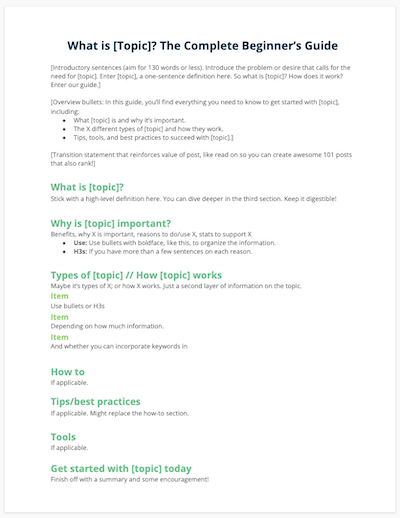
Go to the free blog post templates.
Get more website traffic with on-point on-page SEO
Now can you see why on-page SEO is that below-the-surface hustle? There is a lot of legwork that goes into it. But the more you do it, the easier it gets—and the more traffic you’ll get to your website. To recap, here’s how to do on-page SEO:
- Do your keyword research and target only one keyword or keyword theme per page.
- Write accurate, organized, actionable, and in-depth content on the targeted keyword
- Place your keyword in the title, headings, images, meta description, URL, and first 100 words of the page.
- Compress and resize images, and include the keyword in the alt text and file name.
- Use a compelling title that conveys value, front-loaded with the keyword.
- Use headings to convey information hierarchy, with the keyword in at least two H2 headings.
- Write a benefit-focused meta description that contains the keyword.
- Include 1-3 external links to high-quality sites plus internal links.
- Keep the URL short, descriptive, with dashes between words and include the keyword.
- Check for mobile compatibility, page speed, and indexation.
- Periodically update and refresh the page elements to maintain content freshness.



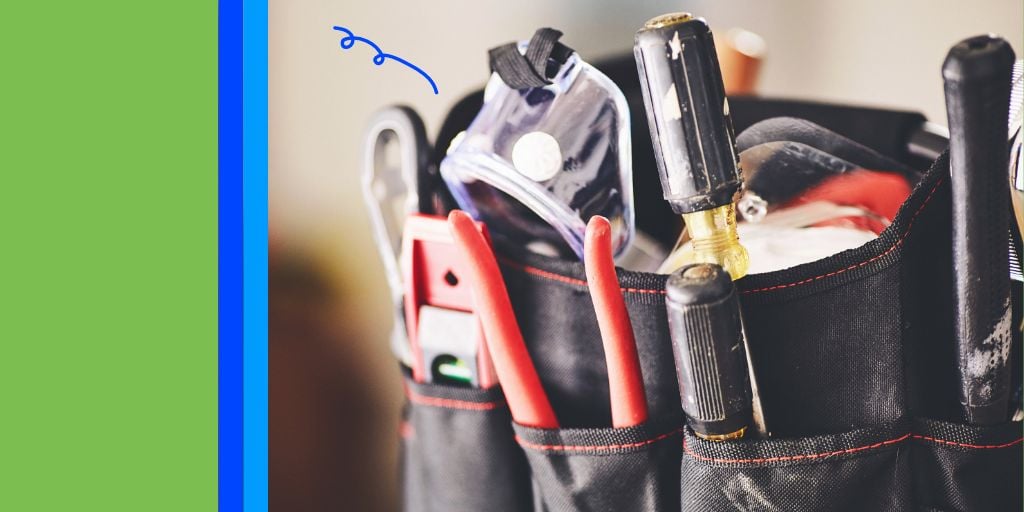





Comments
Please read our Comment Policy before commenting.